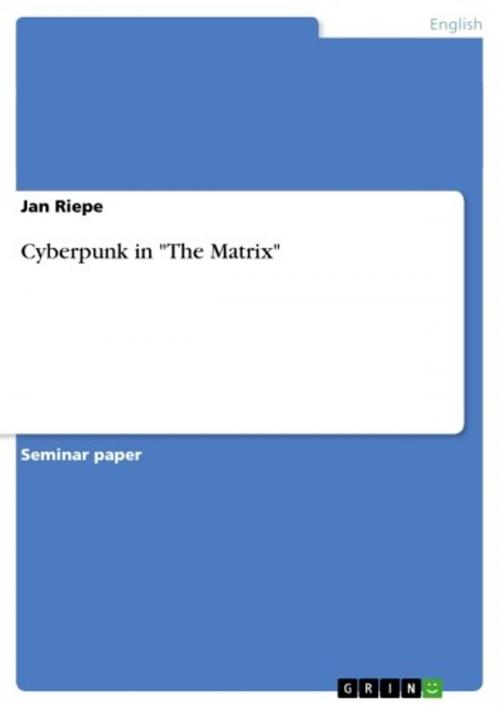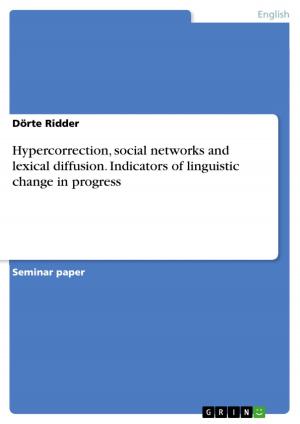| Author: | Jan Riepe | ISBN: | 9783638374460 |
| Publisher: | GRIN Publishing | Publication: | May 6, 2005 |
| Imprint: | GRIN Publishing | Language: | English |
| Author: | Jan Riepe |
| ISBN: | 9783638374460 |
| Publisher: | GRIN Publishing |
| Publication: | May 6, 2005 |
| Imprint: | GRIN Publishing |
| Language: | English |
Seminar paper from the year 2003 in the subject American Studies - Culture and Applied Geography, grade: 1,3, University of Freiburg (Englisches Seminar), course: Proseminar 'American Film Genre', 20 entries in the bibliography, language: English, abstract: It is the aim of this paper to show that The Matrix, written and directed by Larry and Andy Wachowski, is a development of cyberpunk. On the one hand, The Matrix shares many basic ideas, typical features and motifs with cyberpunk, as we know it from the works of William Gibson, Bruce Sterling and other cyberpunk writers of the 1980s. But on the other hand The Matrix's cyberpunk also differs very much from other cyberpunk works. It not only differs, inmany cases The Matrix pushes ideas and motifs of cyberpunk further, taking them to another level. In this paper I will analyze themes, topics and motifs of cyberpunk in The Matrix, the way they are used and, most important, the purpose behind cyberpunk in the film. I will look at how and for what effect cyberpunk is used in The Matrix. In the introduction to his cyberpunk anthology Mirrorshades, Bruce Sterling writes that central themes of cyberpunk are 'the theme of body invasion: prosthetic limbs, implanted circuitry, cosmetic surgery, generic alteration [...] and the 'theme of mind invasion: brain - computer interfaces, artificial intelligence'1. Sterling writes about literature but it makes sense to use his characteristics of cyberpunk in this paper because 'The Matrix is a work of literature'2, has 'careful attention to symbolic detail throughout the movie [...] [and] the script went through seventeen rewrites'3. The themes, topics and motifs I will examine in the film are cyber-system and punk, computer-brain interface, the use of mirrors and mirrorshades and rain. I will look at the film's dystopian setting and analyze the topic of technophobia, which is one of the effects of the technological dystopia. Writing about cyberpunk, it is useful to have a look at the term itself, so the following two quotations should provide a definition, or at least an explanation of the concept of cyberpunk: [...] 1 Bruce Sterling. 'Preface'. Mirrorshades. The Cyberpunk Anthology . Bruce Sterling (ed.). Paladin Grafton Books, 1986. repr. Glasgow, 1990. p. xi 2 Mark Crosby. 'Reflections Upon The Matrix'. Film Philosophy 3.31 (1999). 24 February 2003.. 3 Steve Kellmeyer. The New Gnostic Gospel. 24 February 2003. .
Seminar paper from the year 2003 in the subject American Studies - Culture and Applied Geography, grade: 1,3, University of Freiburg (Englisches Seminar), course: Proseminar 'American Film Genre', 20 entries in the bibliography, language: English, abstract: It is the aim of this paper to show that The Matrix, written and directed by Larry and Andy Wachowski, is a development of cyberpunk. On the one hand, The Matrix shares many basic ideas, typical features and motifs with cyberpunk, as we know it from the works of William Gibson, Bruce Sterling and other cyberpunk writers of the 1980s. But on the other hand The Matrix's cyberpunk also differs very much from other cyberpunk works. It not only differs, inmany cases The Matrix pushes ideas and motifs of cyberpunk further, taking them to another level. In this paper I will analyze themes, topics and motifs of cyberpunk in The Matrix, the way they are used and, most important, the purpose behind cyberpunk in the film. I will look at how and for what effect cyberpunk is used in The Matrix. In the introduction to his cyberpunk anthology Mirrorshades, Bruce Sterling writes that central themes of cyberpunk are 'the theme of body invasion: prosthetic limbs, implanted circuitry, cosmetic surgery, generic alteration [...] and the 'theme of mind invasion: brain - computer interfaces, artificial intelligence'1. Sterling writes about literature but it makes sense to use his characteristics of cyberpunk in this paper because 'The Matrix is a work of literature'2, has 'careful attention to symbolic detail throughout the movie [...] [and] the script went through seventeen rewrites'3. The themes, topics and motifs I will examine in the film are cyber-system and punk, computer-brain interface, the use of mirrors and mirrorshades and rain. I will look at the film's dystopian setting and analyze the topic of technophobia, which is one of the effects of the technological dystopia. Writing about cyberpunk, it is useful to have a look at the term itself, so the following two quotations should provide a definition, or at least an explanation of the concept of cyberpunk: [...] 1 Bruce Sterling. 'Preface'. Mirrorshades. The Cyberpunk Anthology . Bruce Sterling (ed.). Paladin Grafton Books, 1986. repr. Glasgow, 1990. p. xi 2 Mark Crosby. 'Reflections Upon The Matrix'. Film Philosophy 3.31 (1999). 24 February 2003.. 3 Steve Kellmeyer. The New Gnostic Gospel. 24 February 2003. .















